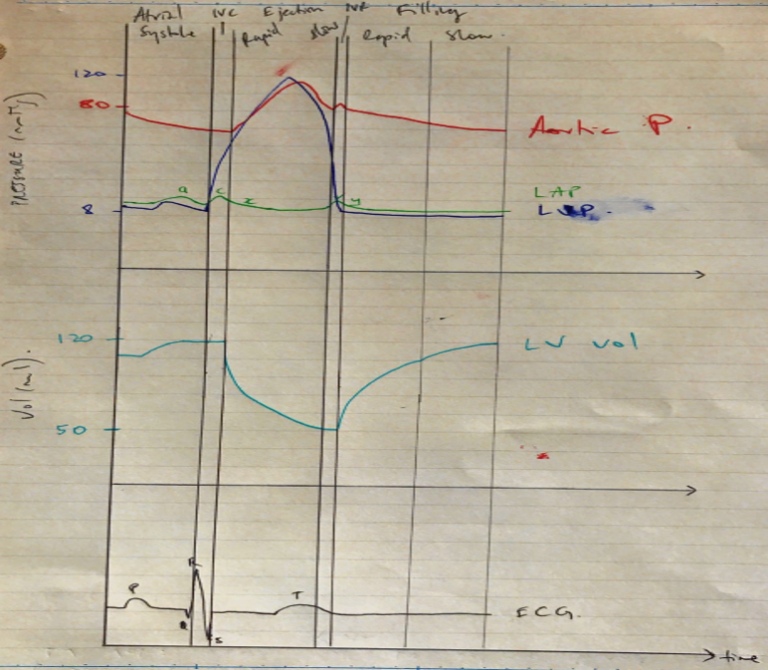18A12: Exam Report
Briefly describe the cardiac events that occur during ventricular diastole.
29% of candidates passed this question.
Many answers lacked structure and contained insufficient information. Better answers defined diastole and described the mechanical events in the 4 phases of diastole. A common error was the ECG events in diastole. The electrical events and coronary blood flow should have been mentioned.
G2iii / 18A12: Describe the cardiovascular events that occur during ventricular diastole
Diastole = the period of the cardiac cycle where the ventricles relax & fill
- Lusitropy = the ability of cardiac myocytes to relax
- Events of diastole divided into:
- Ionic ∆
- ECG ∆
- Mechanical ∆
NOTE: Most cardiac work occurs during diastole
1) Ionic
- Cytosolic [Ca2+] regulates active events of myocytes
- ↓[Ca2+] causes Ca2+ to dissociate from TnC & inhibits cross-bridging
- ↓Ca2+ is facilitated by:
- SERCA pump → pumps Ca2+ back into SR
- Sarcolemma Ca2+-ATPase → moves Ca2+ extracellularly
- Facilitates myocyte relaxation (lusitropy)
2) ECG
- Isovolumetric relaxation: ventricular repol. Is being completed → end of T-wave on ECG
- Rapid filling: no electrical activity by cardiac cells ∴isoeletric line on ECG
- Slow filling: depol. spreads from SA Node across atria → P wave on ECG
- Atrial contraction: atrial depol. complete → end of P wave. Depol spreads from atria → AV Node = PR segment on ECG
3) Mechanical Events
- There are 4 phases of ventricular diastole
- Isovolumetric relaxation
- Rapid filling
- Reduced filling
- Atrial systole
4. Isovolumetric relaxation
- All ventricles relax
- Ventricular pressure falls
- Outflow tract P > ventricular P → blood flow reverses → aortic + pulmonary valves shut
- Valves shut = S2 = commencement of DIASTOLE
- All valves are shut → ventricular volumes remain constant
- Volume in ventricle KA ESV ~50mL
5. Rapid filling
- Atrial P > ventricular P → AV valves open
- Ventricle fills with blood → fast because atria were so full prior to AV valve opening
- Filling is passive
- Once ventricles are fully relaxed → their pressure begins to rise as they fill
6. Reduced filling
- Passive ventricular filling nears completion
- Ventricle is filling with blood & expanding, but becoming less compliant
- As the ventricular P increases, the rate of blood flow from atria → ventricle will fall
7. Atrial systole
- Atria contract → drives more blood into ventricle
- Atrial pressure falls → reserving pressure gradient across AV valves → AV valves shut
- At the end of this phase, ventricles are filled to their ECV ~120mL with P 3mmHg
